Key Points:
- The corn snake, the Texas brown snake, and the eastern hognose snake are all on our list of copperheads look-alike snakes.
- Many black rat snakes, and mole kingsnakes, resemble the copperhead snake.
- The snakes on this list are often mistaken for copperheads and are killed as a result.
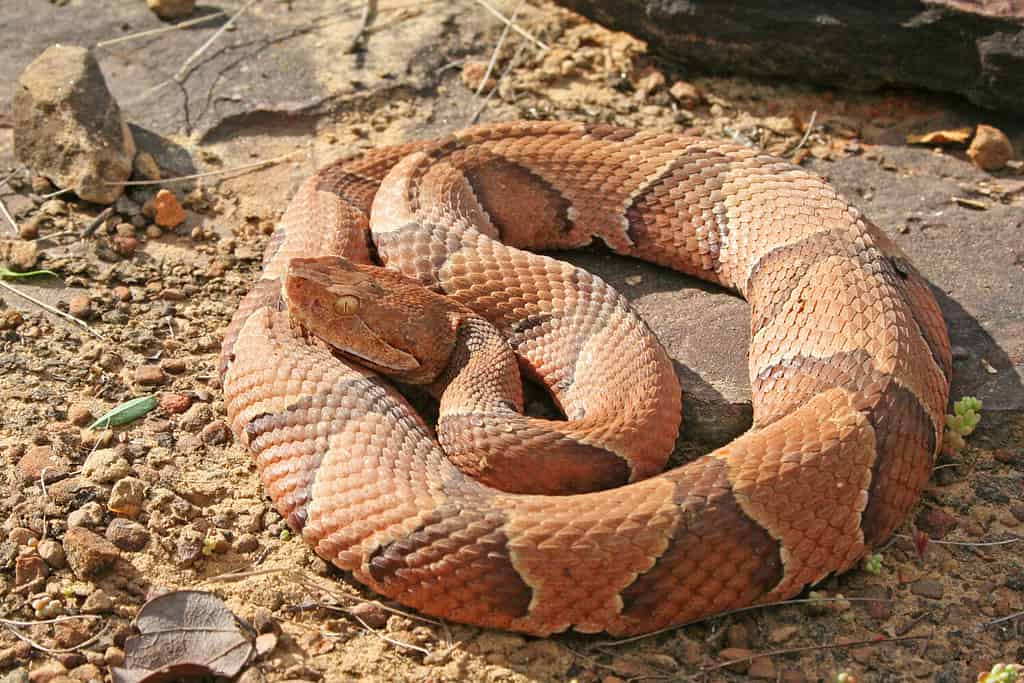
While copperhead snakes are venomous, they only bite when provoked or stepped on unintentionally.
©Creeping Things/Shutterstock.com
The range of the copperhead snake extends from the eastern to the central part of the United States and down into Mexico. They live in forests, swampy areas, hillsides, and on rocky terrain.
This snake is three and a half to four feet long with a thick body. It has brown, gray or even reddish scales paired with a light-colored underbelly. On its back, is a pattern of dark brown bands. Each of these bands has an hourglass shape.
This reptile has two pits on its head that help it to find prey. It’s known as a pit viper. Maybe the most notable feature of this snake is its triangular head.
Each year, several other types of snakes are mistaken for copperheads. Unfortunately, many of these lookalike snakes are killed as a result. Why? Because some people are under the impression that the copperhead’s bite is deadly. While copperhead snakes are venomous, they only bite when they are provoked or stepped on unintentionally.
Like many other snakes, copperheads would rather stay hidden from people. Furthermore, even if a copperhead bites someone, it’s not likely to deliver enough venom to be deadly.
Check out eight of these lookalike snakes and learn why they’re commonly mistaken for copperheads.

#8 Corn Snake (Pantherophis guttatus)

The name corn snake may have originated from the markings on this snake’s belly, which resemble maize, or Indian corn.
©Enrique Ramos/Shutterstock.com
The corn snake is right at home at the top of a list of snakes mistaken for copperheads. Both of these snakes have reddish scales, but a corn snake’s scales are a darker shade of red. In addition, they both have a pattern of dark bands running down their back.
Look closely at the pattern and you’ll see a difference. The corn snake has a series of dark splotches on its back whereas a copperhead has a pattern made up of hourglass shapes.
The corn snake may have come from the similarity in texture and color to corn stock or Indian corn. These snakes are considered variations in color and pattern and depending on their age, their colors may change. Often these snakes are confused for copperhead snakes when adults, when hatchlings they lack the brighter coloration seen in adults.
One of the most obvious features differentiating these snakes is head shape. A copperhead has a triangular-shaped head, and a corn snake has a narrow, thin head. Keep in mind that though they are somewhat similar in appearance, copperheads are venomous and corn snakes are non-poisonous.
Read here for more information on the corn snake.
#7 Northern Water Snake (Nerodia sipedon)

Northern water snakes are also confused with another Connecticut snake, the venomous northern copperhead.
©jmarino/Shutterstock.com
When looking at a picture of a Northern water snake and a copperhead it can be easy to believe they are the same reptile. Northern water snakes have gray, brown, or reddish scales similar to copperheads. Plus, they share a similar pattern of scales on their backs.
But there are some differences to note.
Normally, a copperhead measures 20-27 inches in length while a Northern water snake is a little longer at 24-42 inches. Also, in terms of habitat, a Northern water snake makes its home near streams, lakes, and creeks. A copperhead spends most of its time on land.
Though Northern water snakes bite, they are not venomous like copperheads.
Look at these facts to learn more about Northern water snakes.
#6 Eastern Hognose Snake (Heterodon platyrhinos)
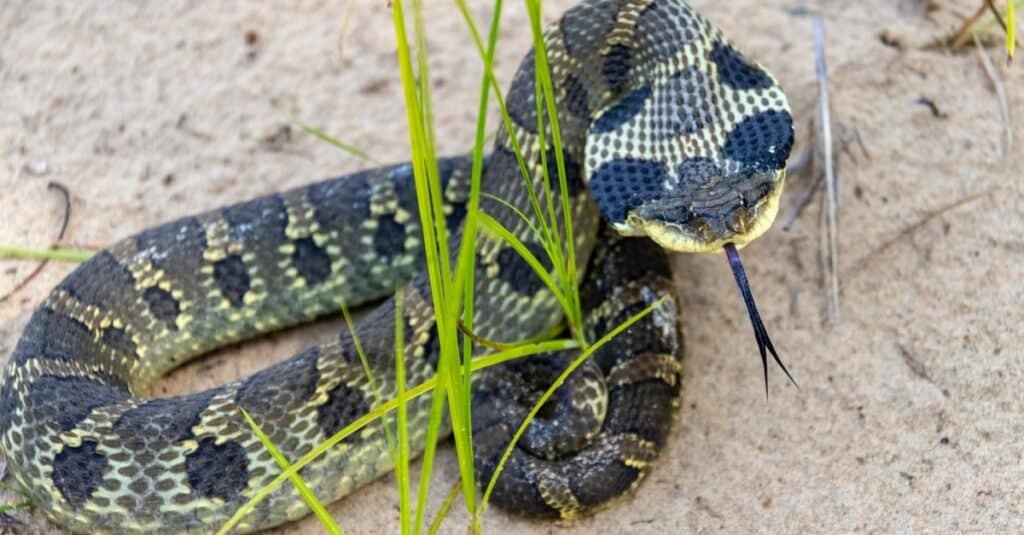
The eastern hognose snake will flatten its head and neck and hiss loudly when threatened.
©IHX/Shutterstock.com
A particular behavior of the Eastern hognose snake has fooled some people into thinking it’s a copperhead. The Eastern hognose doesn’t have a triangular head like a copperhead. However, when it feels threatened by a person or other animal, it puffs out its neck area and this makes its head take on a triangular shape.
This has earned them the name “puff adder.”
Like other snakes on this list, the Eastern hognose snake has a series of dark bands on its back. But the bands on an Eastern hognose snake are narrow and don’t have an hourglass shape.
One easy way to tell these two venomous reptiles apart is an Eastern hognose snake has an upturned nose while a copperhead has a flat one.
Find more facts here on Eastern hognose snakes.
#5 Black Racer Snake (Coluber constrictor priapus)

The black racer is an agile and very fast animal that can “run” (crawl) four miles per hour when threatened.
©Breck P. Kent/Shutterstock.com
There are very few similarities between an adult black racer snake and a copperhead. However, juvenile Black racer snakes and adult copperheads share a similar appearance. A juvenile black racer snake has light-colored scales on its back with a pattern of dark blotches.
This is why they are mistaken for copperheads.
A simple way to differentiate a juvenile Black racer snake from an adult copperhead is the juvenile black racer is much shorter. Another big difference between these snakes is that the black racer is non-venomous.
Study more on racers right here.
#4 Texas Brown Snake (Storeria dekayi texana)
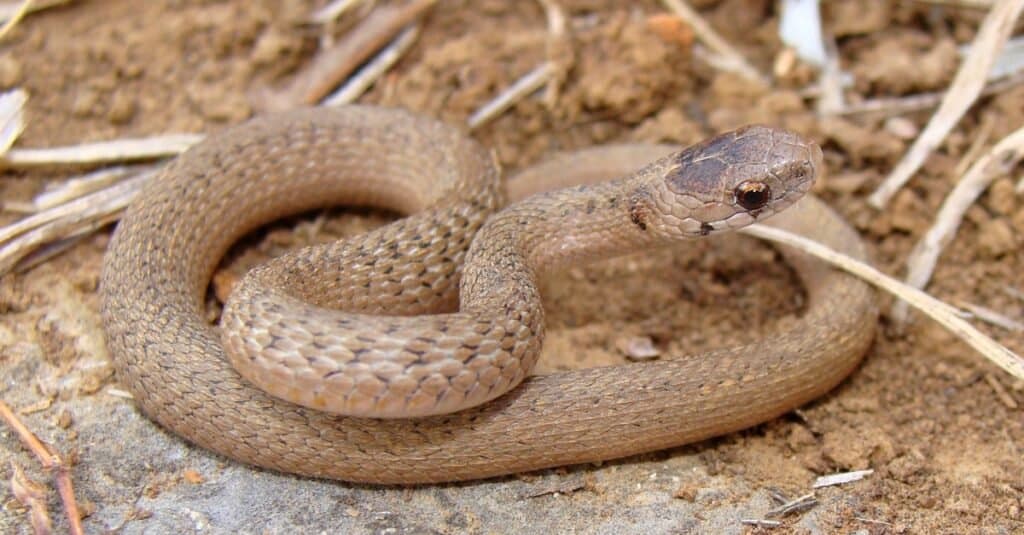
The Texas brown snake has the same brown and reddish scales as a copperhead.
©Matt Jeppson/Shutterstock.com
Someone seeing a Texas brown snake disappears under a rock may think they’ve just seen a copperhead. A Texas brown snake is a subspecies of Dekay’s brown snake and has the same brown and reddish scales as a copperhead along with dark splotches on its back.
But Texas brown snakes are much shorter than copperheads and their bodies are thinner. Plus, Texas brown snakes are non-venomous and found in urban areas more often than copperheads.
Read more about the Texas brown snake here.
#3 Mole Kingsnake (Lampropeltis rhombomaculata)
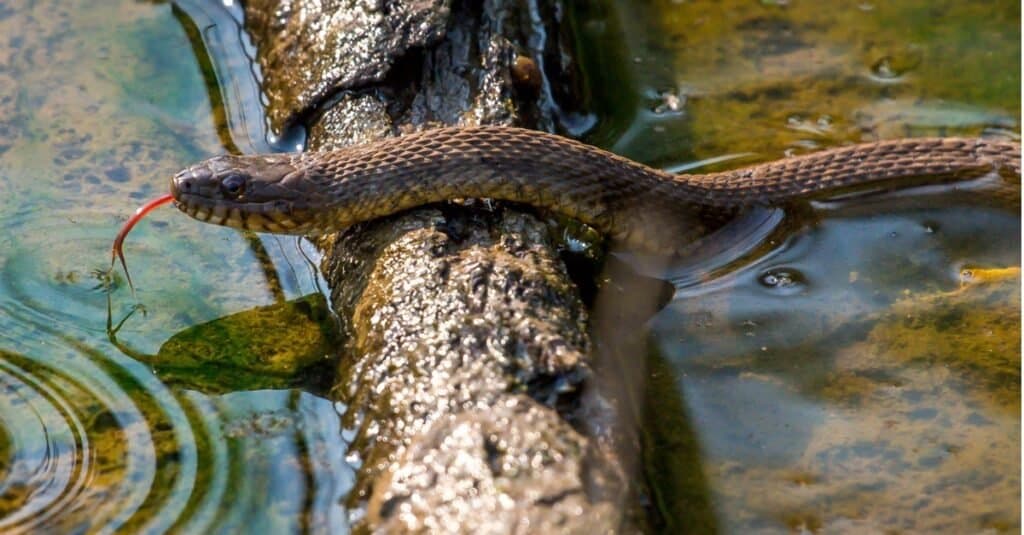
Mole kingsnakes are rarely seen in the wild since they tend to be fossorial, spending much of their time underground and out of sight.
©iStock.com/William Krumpelman
Mole kingsnakes and copperheads both have reddish-brown scales. But a close comparison reveals that a mole kingsnake’s scales are a brighter shade of red. Also, a mole kingsnake has tiny, dark eyes with round pupils.
Alternatively, a copperhead has light-colored or yellowish eyes with vertical pupils.
In terms of behavior, mole kingsnakes are known to go out in rainy, damp weather. Alternatively, copperheads are more active on warm, sunny days.
#2 Eastern Milk Snake (Lampropeltis triangulum)
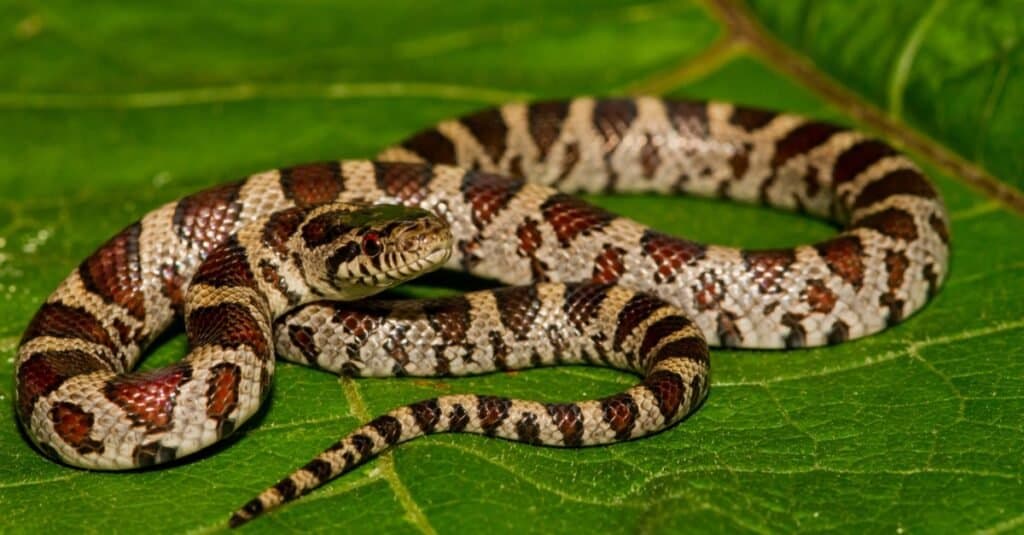
Eastern milk snakes are very beneficial animals, especially for farmers, as they hunt down small rodents often found on farm buildings.
©Jay Ondreicka/Shutterstock.com
Though both snakes have dark bands on their backs, the Eastern milk snake’s colors are brighter. The black border around its reddish-brown splotches makes the pattern stand out even more.
Examine the head of an Eastern milk snake and you’ll see a dark band in a Y-shape. Also, the Eastern milk snake has a thinner body than a copperhead.
Eastern milk snakes have a reputation for being docile and shy. They are less likely than a copperhead to stand their ground against a threat. Eastern milk snakes are non-venomous.
For more on milk snakes read here.
#1 Eastern Rat Snake (Pantherophis alleghaniensis)
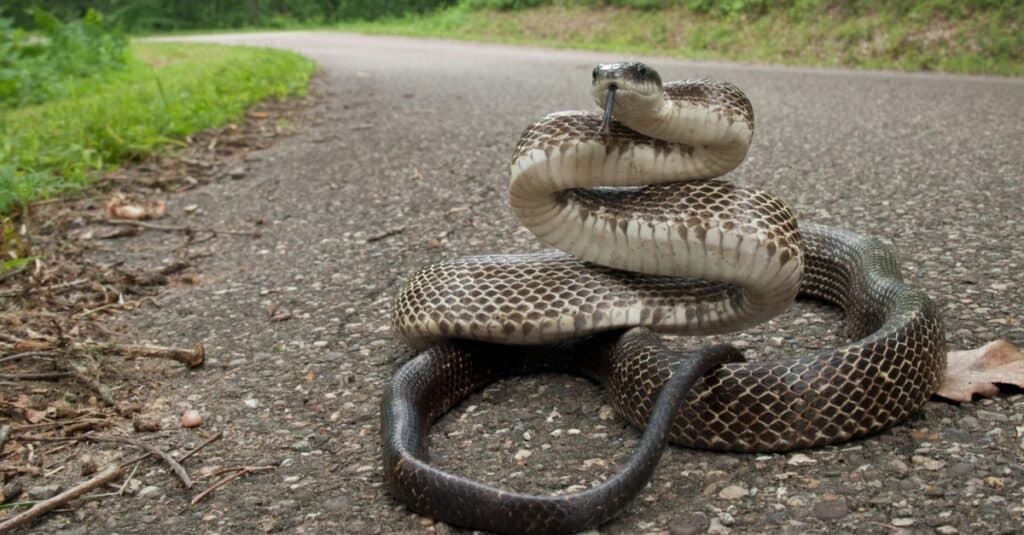
When threatened, rat snakes will “rattle” their tail, fooling other animals into believing they are venomous.
©Mike Wilhelm/Shutterstock.com
As a juvenile, the Eastern rat snake, aka black rat snake, is similar to a copperhead. A juvenile Eastern rat snake has a pattern of brown splotches on a light gray background of scales. This fools some folks into thinking they’ve spotted a copperhead. However, a copperhead has a much wider body than a juvenile Eastern rat snake.
Like many other snakes, Eastern rat snakes like to sun themselves on warm days. But as the cold weather approaches, this snake is likely to move into the attic of a home to stay warm. Alternatively, copperheads don’t normally look for shelter in places occupied by people.
Read on for more on Eastern rat snakes.
Summary of Eight Snakes That Look like Copperheads
Here is our list of snake species that have a similar appearance to copperheads:
| Rank | Copperhead Look-a-Likes |
|---|---|
| 1 | Eastern Rat Snake |
| 2 | Eastern Milk Snake |
| 3 | Mole Kingsnake |
| 4 | Texas Brown Snake |
| 5 | Black Racer Snake |
| 6 | Eastern Hognose Snake |
| 7 | Northern Water Snake |
| 8 | Corn Snake |
The photo featured at the top of this post is © Joe McDonald/Shutterstock.com
Discover the "Monster" Snake 5X Bigger than an Anaconda
Every day A-Z Animals sends out some of the most incredible facts in the world from our free newsletter. Want to discover the 10 most beautiful snakes in the world, a "snake island" where you're never more than 3 feet from danger, or a "monster" snake 5X larger than an anaconda? Then sign up right now and you'll start receiving our daily newsletter absolutely free.
FAQs (Frequently Asked Questions)
How big do copperheads get?
Generally, copperheads don’t exceed about three feet in length. However, some specimens can reacher larger sizes. The largest copperhead on record reaches 53 inches, or 4 feet 5 inches long.
Thank you for reading! Have some feedback for us? Contact the AZ Animals editorial team.







